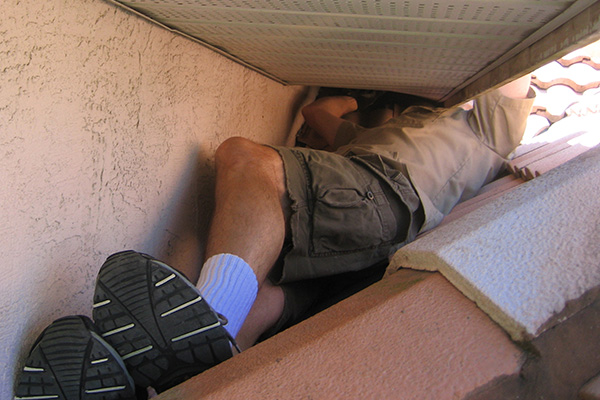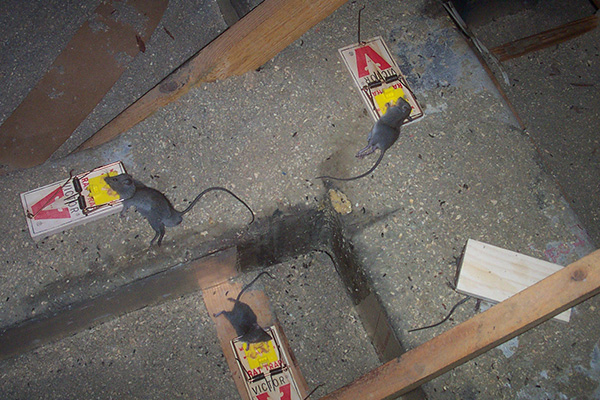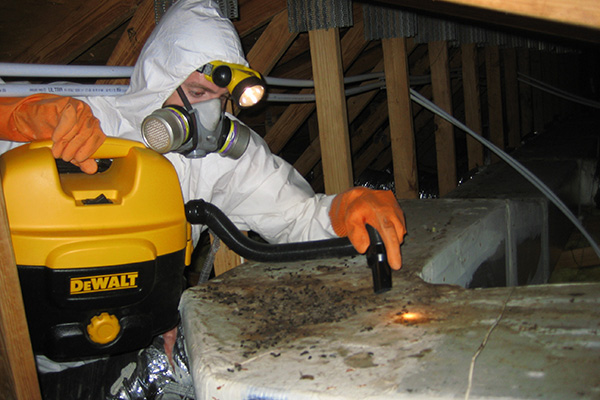- info@animalatticpest.com
- Call - we service 300 locations

How To Get Rats Out of Your Attic
Rats love to live in attics. These animals are classified as "commensal rodents" because they thrive in association with people. To a Roof Rat, a house is a far better shelter than anything out in the wild. And the best part of the house is usually the attic. Though these rats do also live in the walls, the basement, your kitchen pantry, and so on. But the attic is usually the home base. The first sign of rats in the attic is the scurrying or scratching usually in the ceiling or walls during the night hours. Rodents are nocturnal so the noise is usually a pitter-patter or scurrying at night, and is often the first thing the homeowner notices. One reason rats use your attic is to establish nesting areas. A female rat can have up to five litters of young per year, and up to a dozen young per litter! And rats are able to reproduce when only four months old! This is the reason rat populations can explode to infestation levels very quickly. Though the limiting factor is usually food availability. They are very capable animals, and they can climb almost any surface and jump very far. They can squeeze into very small holes, about the size of a squarter, or a gap in the architecture as little as 5/8" thick! It's amazing! Thus they have no problem finding the entry points into your attic - usually through many areas from ground to roof, from poorly screened roof vents, places where the soffit meets the roof, eave vents, loose siding, areas where pipes enter, even the plumbing system. Your home might have several entry areas. The general process to get rid of rats in the attic is as such: First, inspect the house to find out how the rats are getting inside. Second, inspect the attic to find out what kind of damage they have caused, from chewed wires to nesting debris. Third, seal shut 100% of the entry holes, with metal or steel screen, which they can't chew. This is important - seal first! Then trap and remove the animals, most commonly via trapping with snap traps or with one-way exclusion doors. DO NOT USE POISON. Read about how to kill rats. Fourth, repair any damage such as chewed wires, and clean and decontaminate the attic if necessary. You may want to get rid of rats in the attic fast and easy, but to do it correctly, and to do it permanently, it is work. Read more about how much does rat removal cost.
How to Get Rid of Rats in the Attic - 4 How-To Steps
1 - Home & Attic Inspection
A full inspection of the exterior of the home, including the roof and all vents, to find out how they are getting in. Plus an inspection inside the attic to identify rat damage.
2 - Repair the Rat Entry Holes
The job will fail unless you solve the source of the problem. Seal shut the entry holes, with professional grade repairs, or else the problem will happen again.
3 - Remove the Rats
AFTER the repair job, set at least a dozen snap traps throughout the attic on the areas of high rat activity. Use wooden snap traps baited with peanut butter.
4 - Clean the Attic
In addition to repairing chewed electrical wires and damaged duct work, you might want to remove the rat feces, maybe the insulation, and decontaminate.
HOW MUCH DOES RAT REMOVAL COST? Prices vary depending on the situation. Some jobs are simple, require only one service visit, and might be as low as $100. Some jobs are complex, require multiple service visits, home repairs, attic cleanup, and so on. Prices can also vary by city. To get the best price estimate, call our technician in your area: Click here for a free price quote over the phone in your town.
Information About Rats in the Attic
Is there a nest of baby rats? Yes, maybe a few. Rats can breed at very high rates. They keep nests in the attic and walls. When removing raccoons or squirrels from an attic, this nest of young is something to consider. But with rats, the nest(s) may be very hard to find, and the young unable to be saved, so I have not made the remove of rat nests an active part of my rat control activities. If you are concerned about baby rats in an attic, the best bet is to prevent the issue in the future by making hour rodent-proof. Read more about nest of baby rats in the attic.
What kind of damage is caused by rats in the attic? First of all, they are rodents, so they chew. They are small, so chewing on wood may not be a big deal. But they can chew on important things like electrical wires or PVC pipes pr PEX tubing for radiant heat systems, or small holes in ductwork, things like that. Electrical wires are a problem because of outages, or exposed wire, which can be a fire hazard. Rats often dig tunnels in the insulaton, and deposit nesting material there, if that bothers you, although I don't consider that a big problem. They do leave feces and urine in the attic, bringing plant matter and nesting material into the attic, chewing on wood beams in the attic, and chewing on electrical wires in the attic. Some of these activities are merely unsanitary, but some can cause a risk of fire hazard. Read more about damage from rats in the attic.
How do I trap rats? Trapping is the most effective means of rat control. But it is only effective after the whole house has been rat-proofed: that is, all possible rat entry holes have been sealed shut with steel repairs. It is pointless to begin a rat trapping program if the house has not been sealed shut. First of all, new rats will continue to enter the house indefinitely as long as they can find open entry holes. Second of all, it is far easier to trap rats once those holes have been sealed shut. Rats are creatures of habit, travelling the same pathways over and over again - like rats in a maze! Once their normal exit/entry holes into the house have been sealed, they change their behavior and seek alternate territory, and seek alternate food. They are far easier to trap at that time. But what type of trap to use? You can purchase several styles and designs of rat trap. There are many types of snap traps, electricution traps, live cage traps, repeating live traps, glue traps, and so on. This site is focused on humane treatment of animals and effective solutions to problems. There is no way to humanely trap rats in live traps. If you block them out of your house, they are done for. They will not survive more than a few days outside, and will be eaten by predators. So it's pointless to live-trap them. It's also incredibly inhumane to use glue boards. Read about inhumane glue boards. The best trap is actually the old standard wooden snap trap. I prefer Victor brand. I have tested over 14 types of rat traps so far, and nothing is as effective as these original wooden snap traps. They can be set in high numbers, on the rat runways, the flat bottom holds them steady in insulation, and the pan tension can be adjusted to hair trigger. Nothing is better. Remember, the key to successful trapping is in sealing shut the house first, then in placing the traps directly on the rat runways second. Bait is of least concern - peanut butter, or a variety of foods, work fine. You actually don't need any bait at all. Read more about rat trapping and about the best type of rat bait.
Can't I just use a rat repellent? No. In my 15+ years as a wildlife removal professional, I have seen it all: attics filled with strobing lights, blaring radios, ultrasonic sound machines, and every type of over-the-counter repellent, from coyote urine flakes, to ammonia, to the end-all-be-all el cheapo scam, mothballs. I once went into an attic in which a desperate old lady had dumped close to 100 lbs. of mothballs in her attic. The rats didn't care! Here's the problem with repellents in general: once a rat lives in your attic, and has a nest of babies there, that's it. That's the only option for survival. There is no device, no repellent that will make them leave. Go ahead and buy a rat repellent at Home Depot, or a rat deterrent device online - waste your time. But they have zero demonstrated effectiveness. Read more about rat repellents.
Can I kill the rats with poison? Most pest control companies use poison for rodent control. They treat rodents the same way they treat insects. The main goal of the pest control company is to never solve your rat problem. They want to put you on a quarterly contract that you pay for, for life. And poisons accomplish that goal: they never solve the problem. As long as your house has open holes and gaps that allow rats to enter, you will forever have a rat infestation. Poison does kill a few of the rats. But not all! Here are the problems with using poison to kill rats. First, not all of them eat the poison. Second, not all of the rats that do eat poison actually die. Third, the rats that live reporoduce so quickly that the population will be back to full level in just a few weeks. Fourth, death by poison is painful and inhumane, by internal bleeding - you may not care, but rats have every bit as much feeling as your pet dog. Fifth, the rats that do die will die in your attic or walls (not that bs myth that "they go outside to drink water"), and the smell of rotting rats caused by poison is horrible - I remove this stink almost every day. Sixth, IT NEVER SOLVES THE PROBLEM because as long as you have open holes leading into your house and attic, you'll have rat problems. You must find and seal shut all of these entry holes. Poison is basically a gigantic hoax perpetuated by a greedy and sleazy billion-dollar industry. Don't fall for this hoax! Do your rat control the correct way! Read more about killing rats with poison.
How do I keep rats away from my house? Maybe you want to prevent rats from coming to your house, roof, garden, or property in the first place, before they get in the attic. Well, it's hard to keep rats away from a property. They can pretty much go wherever they want, and they will, if there's adequate food and water sources. The real key, regarding rats in the attic, is to prevent them from getting inside. On the roof is fine. Inside is not. To do this, you must inspect the house and seal shut any potential rat entry holes, with steel, which rats can't chew through. Other than that, your best bet is to eliminate things that attract rats to your property, such as bird seed, garbage, pet food, fruit plants, water sources, clutter and debris and so on. That said, even the cleanest property is likely to be a good habitat for rats, so there's not much you can do to keep them away from your house. But you can keep them OUT of your house. You can read more about how to keep rats away if you want.
How do I do this myself, for cheap? Follow the 4 steps. First, use a ladder and inspect every inch of your house, especially the roof vents, plumbing stacks, eave gaps, soffits and soffit vents, and everything at ground level too. Then inspect inside the attic to find out more clues about how many rats there are and where they are most commonly entering. Seal shut every possible entry hole using steel mesh, which rats are unable to chew through. This first step is by far the most important thing, and the only crucial thing you must do. Second, set at least a dozen or more snap traps in the attic, on areas of rat activity (look for droppings and trails in the insulation), baited with peanut butter. Continue trapping until no more are caught, and no more sounds are heard. If this takes more than 3-4 days, you probably missed an entry spot or two. Third, once they are all trapped and removed, repair any chewed electrical wires in the attic, and clean the feces and urine. Read more about rat feces. The whole process is difficult, and it took me a couple of years and dozens of jobs before I got very good at it, but if you are very careful and work hard, you can do it!
How much does rat removal cost? It varies by the complexity of the job and by the company doing the work. The job requires several service visits, as outlined above. It will certainly cost at least a few hundred dollars. But doing it the right way is far cheaper than signing up for a lifetime worth of futile pest control poison service visits! If you want to find out a ballpark price in your town, click here for your local wildlife pro and call, and they will be able to tell you. Our wildlife experts have special licensing & certification regulated by state wildlife laws, as well as all applicable state and local business licenses. They carry liability insurance, due to risks of climbing on roofs, in attics, dealing with dangerous wildlife, etc. They will perform professional grade repairs which results in a permanent solution so you don't have rats again. It is a good investment in your home and protection against further damage. Read more about how much does rat removal cost.
The Bottom Line
How to get rid of rats in the attic - they are not so easily just "gotten rid of". But they can be properly and effectively removed, and the problem can be prevented from happening again. Remember to follow the steps above, whether you do it
yourself or hire a professional to do it for you. It is not easy work, but if you don't remove the rats in your attic, they will go on to cause further damage. When you do decide to remove them, please remember to treat the animals with respect,
and take the work seriously. You can get rid of rats in the attic if you follow the correct approach. Best of luck!
You may also want to read:
Home Remedies To Keep Rats Away
Fastest Way To Get Rid Of Rats
If I Have One Rat Are There More?
Do Rats Like Cold Weather?
Do Rats Like Dog Poop?
Do Rats Hide From Humans?
Do Rats Come Out In Light Or Avoid Light?
Do Rats Sleep In The Day?




